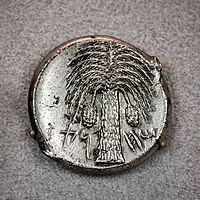Carthaginian coinage
Carthaginian or Punic currency refers to the coins of ancient Carthage, a Phoenician city-state located near present-day Tunis, Tunisia. Between the late fifth century BC and its destruction in 146 BC, Carthage produced a wide range of coinage in gold, electrum, silver, billon, and bronze. The base denomination was the shekel, probably pronounced /səˈḳel/ in Punic.[1] Only a minority of Carthaginian coinage was produced or used in North Africa. Instead, the majority derive from Carthage's holdings in Sardinia and western Sicily.[2]
Background[]
Between the ninth and seventh centuries BC, the Phoenicians established colonies throughout the western Mediterranean, particularly in North Africa, western Sicily, Sardinia, and southern Iberia. Carthage soon became the largest of these communities, establishing particularly close economic, cultural, and political ties with Motya in western Sicily and Sulci in Sardinia.
Although coinage began to be minted by Greek communities in Sicily and Southern Italy around 540 BC, Punic communities did not begin producing coins until around 425 BC. The first Punic mints were in western Sicily, at Motya and Ṣyṣ (probably Panormus, modern Palermo). The coinage that these communities produced is known as . Like the coinage produced by the Greek communities in Sicily, it was minted solely in silver on the Attic-Euboic weight standard, and its iconography was mostly adapted from other pre-existing Sicilian coinages - principally those of Himera, Segesta, and Syracuse.[3] This Siculo-Punic coinage probably preceded Phoenicia's own Tyrian shekels, which developed c. 400 BC.[4]
First Carthaginian coinage (c. 410 - 390 BC)[]


Obverse: Nike flying over horse forepart facing right, grain of wheat at right, legend reads